
National symbols of Serbia
Encyclopedia
National symbols of Serbia ' onMouseout='HidePop("51824")' href="/topics/Romanization">tr.
Nacionalni simboli) are the symbols that are used in Serbia
to represent what is unique about the nation, reflecting different aspects of its cultural life and history.
Romanization
In linguistics, romanization or latinization is the representation of a written word or spoken speech with the Roman script, or a system for doing so, where the original word or language uses a different writing system . Methods of romanization include transliteration, for representing written...
Nacionalni simboli) are the symbols that are used in Serbia
Serbia
Serbia , officially the Republic of Serbia , is a landlocked country located at the crossroads of Central and Southeast Europe, covering the southern part of the Carpathian basin and the central part of the Balkans...
to represent what is unique about the nation, reflecting different aspects of its cultural life and history.
Official symbols
| Symbol | Media | Remarks |
|---|---|---|
| Flag Flag A flag is a piece of fabric with a distinctive design that is usually rectangular and used as a symbol, as a signaling device, or decoration. The term flag is also used to refer to the graphic design employed by a flag, or to its depiction in another medium.The first flags were used to assist... : Flag of Serbia Flag of Serbia The flag of Serbia is a tricolour consisting of three equal horizontal bands, red on the top, blue in the middle and white on the bottom. The same tricolour, in some variations, was the flag of Serbia throughout its history, and is the ethnic flag of the Serbian people.The state flag bears the... |
 |
The flag includes the Serbian cross Serbian cross The Serbian Cross is a national symbol of Serbia, part of the Coat of Arms of Serbia, and the flag of Serbia. It is composed of a cross symbol with four C-shapes on each of its corners, in use as a national emblem since the 14th century.... , Coat of arms Coat of arms of Serbia The coat of arms of Serbia is based the family arms of the former Obrenović dynasty and features the white bicephalic eagle of the Nemanjić dynasty. An ermine cape of the style once worn by kings is featured in the background. The double-headed eagle has been used since Byzantine era, the Serbian... and Serbian tricolour. Adopted August 16, 2004. |
| National anthem National anthem A national anthem is a generally patriotic musical composition that evokes and eulogizes the history, traditions and struggles of its people, recognized either by a nation's government as the official national song, or by convention through use by the people.- History :Anthems rose to prominence... Bože pravde Bože pravde "Bože pravde" is the official anthem of Serbia, as defined by the Article 7 of the Constitution of Serbia. "Bože pravde" was the anthem of the Principality of Serbia and Kingdom of Serbia until 1918 when Kingdom of Serbs, Croats and Slovenes was formed. It was recommended by the Parliament of... |
"Bože pravde" was the anthem of the Principality of Serbia and Kingdom of Serbia Kingdom of Serbia The Kingdom of Serbia was created when Prince Milan Obrenović, ruler of the Principality of Serbia, was crowned King in 1882. The Principality of Serbia was ruled by the Karađorđevic dynasty from 1817 onwards . The Principality, suzerain to the Porte, had expelled all Ottoman troops by 1867, de... until 1918 when Kingdom of Serbs, Croats and Slovenes was formed. Adopted November 8, 2006. |
|
| National colours National colours National colours are frequently part of a country's set of national symbols.Many states and nations have formally adopted a set of colours as their official "national colours" while others have de facto national colours that have become well-known through popular use... Red Red Red is any of a number of similar colors evoked by light consisting predominantly of the longest wavelengths of light discernible by the human eye, in the wavelength range of roughly 630–740 nm. Longer wavelengths than this are called infrared , and cannot be seen by the naked eye... , Blue Blue Blue is a colour, the perception of which is evoked by light having a spectrum dominated by energy with a wavelength of roughly 440–490 nm. It is considered one of the additive primary colours. On the HSV Colour Wheel, the complement of blue is yellow; that is, a colour corresponding to an equal... and White White White is a color, the perception of which is evoked by light that stimulates all three types of color sensitive cone cells in the human eye in nearly equal amounts and with high brightness compared to the surroundings. A white visual stimulation will be void of hue and grayness.White light can be... |
|
Red, Blue and White (Serbian tricolour) were used as colours in the Flag of the Principality of Serbia (1830-1882). The national colours are used by the Red, Blue and White are also the traditional team colors of Serbian national sports teams. |
| Coat of arms Coat of arms A coat of arms is a unique heraldic design on a shield or escutcheon or on a surcoat or tabard used to cover and protect armour and to identify the wearer. Thus the term is often stated as "coat-armour", because it was anciently displayed on the front of a coat of cloth... Coat of arms of Serbia Coat of arms of Serbia The coat of arms of Serbia is based the family arms of the former Obrenović dynasty and features the white bicephalic eagle of the Nemanjić dynasty. An ermine cape of the style once worn by kings is featured in the background. The double-headed eagle has been used since Byzantine era, the Serbian... |
 |
Originally Coat of Arms of Kingdom of Serbia Kingdom of Serbia The Kingdom of Serbia was created when Prince Milan Obrenović, ruler of the Principality of Serbia, was crowned King in 1882. The Principality of Serbia was ruled by the Karađorđevic dynasty from 1817 onwards . The Principality, suzerain to the Porte, had expelled all Ottoman troops by 1867, de... (1882), re-adopted 2004. |
Unofficial Emblems
| Symbol | Image | Remarks |
|---|---|---|
| Only Unity Saves the Serbs Only Unity Saves the Serbs Only Unity Saves the Serbs is an unofficial motto used in Serbia and a popular slogan among Serbs, often used as a rallying call against foreign domination and during times of national crisis.... (Unity; Solidarity) |
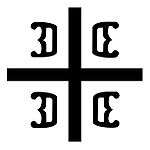 |
The phrase is displayed on the Serbian cross Serbian cross The Serbian Cross is a national symbol of Serbia, part of the Coat of Arms of Serbia, and the flag of Serbia. It is composed of a cross symbol with four C-shapes on each of its corners, in use as a national emblem since the 14th century.... on the Serbian national coat of arms Coat of arms A coat of arms is a unique heraldic design on a shield or escutcheon or on a surcoat or tabard used to cover and protect armour and to identify the wearer. Thus the term is often stated as "coat-armour", because it was anciently displayed on the front of a coat of cloth... , in the form of four C-shaped firesteels (Serbian Serbian language Serbian is a form of Serbo-Croatian, a South Slavic language, spoken by Serbs in Serbia, Bosnia and Herzegovina, Montenegro, Croatia and neighbouring countries.... : "ocila", "оцила"), which form an acronym of four Cyrillic letters for "S" (written like Latin "C"). |
| Wolf Canis Lupus |
|
Unofficial national mammal animal |
| Floral emblem In a number of countries, plants have been chosen as symbols to represent specific geographic areas. Some countries have a country-wide floral emblem; others in addition have symbols representing subdivisions. Different processes have been used to adopt these symbols - some are conferred by... Plum Plum A plum or gage is a stone fruit tree in the genus Prunus, subgenus Prunus. The subgenus is distinguished from other subgenera in the shoots having a terminal bud and solitary side buds , the flowers in groups of one to five together on short stems, and the fruit having a groove running down one... Prunus |
|
It is a fruit tree which is known for Rakija production in Serbia. |
| Šljivovica |
|
Plum brandy. Protected designation of origin Protected designation of origin Protected Geographical Status is a legal framework defined in European Union law to protect the names of regional foods. Protected Designation of Origin , Protected Geographical Indication and Traditional Speciality Guaranteed are distinct regimes of geographical indications within the framework... . |
| Eagle (Serbian eagle Serbian eagle The double-headed eagle is a common symbol in Serbian heraldry and vexillology; the heads represent the dual sovereignty of the emperor and/or dominance of the Byzantine Emperors over both East and West.... ) |
The White Eagle is depicted on the royal houses of Nemanjić House of Nemanjic The Nemanjić was the most important dynasty of Serbia in the Middle Ages, and one of the most important in Southeastern Europe. The royal house produced eleven Serbian monarchs between 1166 and 1371. It's progenitor was Stephen Nemanja, who descended from a cadet line of the Vukanović dynasty... , Mrnjavčević House of Mrnjavcevic The House of Mrnjavčević was a medieval Serbian noble house that existed during the Serbian Empire, its fall, and the subsequent years when it held a region of present-day Macedonia region. The house ruled a province from its base at Prilep from 1366 to 1395.Vukašin Mrnjavčević was a military... , Lazarević House of Lazarevic The House of Lazarević was a noble Serbian medieval dynasty.The dynasty starts with Lazar Hrebeljanović, son of Pribac Hrebeljanović -a noble at the court of Dušan the Mighty and of Princess Jelena Zupan Rascia-Nemanjic of Serbia... , Crnojević House of Crnojevic The Crnojević was a medieval Serb noble house that held Zeta, or parts of it; a region corresponding to north of Lake Skadar , from 1326 to 1362, then 1403 until 1515. The progenitor, Đuraš Ilijić, was head of Upper Zeta in the Serbian Kingdom and Empire The Crnojević was a medieval Serb noble... , Obrenović House of Obrenovic The House of Obrenović was a Serbian dynasty that ruled Serbia from 1815 to 1842, and again from 1858 to 1903. They came to power through the leadership of their progenitor Miloš Obrenović in the Second Serbian uprising against the Ottoman Empire, which led to the formation of the Principality of... and Karađorđević, and is used on the Coat of arms of Serbia Coat of arms of Serbia The coat of arms of Serbia is based the family arms of the former Obrenović dynasty and features the white bicephalic eagle of the Nemanjić dynasty. An ermine cape of the style once worn by kings is featured in the background. The double-headed eagle has been used since Byzantine era, the Serbian... and the Flag of Serbia Flag of Serbia The flag of Serbia is a tricolour consisting of three equal horizontal bands, red on the top, blue in the middle and white on the bottom. The same tricolour, in some variations, was the flag of Serbia throughout its history, and is the ethnic flag of the Serbian people.The state flag bears the... . |
|
| Patron saint Patron saint A patron saint is a saint who is regarded as the intercessor and advocate in heaven of a nation, place, craft, activity, class, clan, family, or person... Saint Sava Saint Sava Saint Sava was a Serbian Prince and Orthodox monk, the first Archbishop of the autocephalous Serbian Church, the founder of Serbian law and literature, and a diplomat. Sava was born Rastko Nemanjić , the youngest son of Serbian Grand Župan Stefan Nemanja , and ruled the appanage of Hum briefly in... |
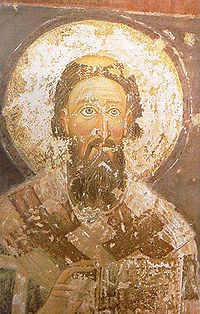 |
Founder and First Archbishop of Serbian Orthodox Church Serbian Orthodox Church The Serbian Orthodox Church is one of the autocephalous Orthodox Christian churches, ranking sixth in order of seniority after Constantinople, Alexandria, Antioch, Jerusalem, and Russia... (1219–1233). |
| National tree Oak Oak An oak is a tree or shrub in the genus Quercus , of which about 600 species exist. "Oak" may also appear in the names of species in related genera, notably Lithocarpus... |
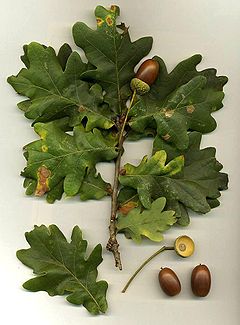 |
The Oak was depicted in the Coat of Arms of Serbia 1835-1882 and 1947-2004. Oak is a sacred tree, used in Serbian Christmas traditions Serbian Christmas traditions The Serbian Orthodox Church uses the traditional Julian Calendar. From 1900 until 2100, the Julian calendar is 13 days behind the Gregorian and therefore Serbian Christmas Day falls on 7 January of the Gregorian calendar... : Badnjak. |
Cathedral of Saint Sava |
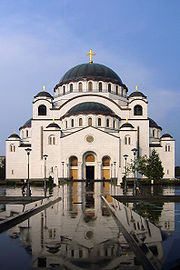 |
The largest Orthodox cathedral in the world. The church is dedicated to Saint Sava Saint Sava Saint Sava was a Serbian Prince and Orthodox monk, the first Archbishop of the autocephalous Serbian Church, the founder of Serbian law and literature, and a diplomat. Sava was born Rastko Nemanjić , the youngest son of Serbian Grand Župan Stefan Nemanja , and ruled the appanage of Hum briefly in... . It is built on the Vračar Vracar Vračar is an urban neighborhood and one of 17 municipalities which constitute the City of Belgrade. With an area of only , it is the smallest of all Belgrade's municipalities, but also the most densely populated. Vračar is one of the three municipalities that constitute the central area of the... plateau, on the location where his remains were burned in 1595 by the Ottoman Empire's Sinan Pasha Sinan Pasha Sinan Pasha or Sinan Pashë Kahremanliu was an Albanian Grand Vizier, Ottoman military commander and statesman.-Life:... . From its location, it dominates Belgrade's cityscape Cityscape A cityscape is the urban equivalent of a landscape. Townscape is roughly synonymous with cityscape, though it implies the same difference in urban size and density implicit in the difference between the words city and town. In urban design the terms refer to the configuration of built forms and... , and is perhaps the most monumental building in the city. |
Kosovo Maiden Kosovo Maiden The Kosovo Maiden or Maiden of the Blackbird Field is the central figure of a poem with the same name, part of the Kosovo cycle in the Serbian epic poetry. In it, a young beauty searches the battlefield for her betrothed husband and helps wounded Serbian warriors with water, wine and bread after... |
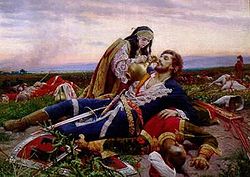 |
Central figure of a poem with the same name |
Šajkača Šajkaca The Šajkača is the Serbian national hat or cap.-History:The Šajkača originated in the 18th century. It was originally worn by the Serbian river fleet as a military headgear in the service of the Habsburg Empire around the Danube and Sava Rivers... |
 |
Commonly seen as part of the National costume of the Šumadija Šumadija Šumadija is a geographical region in Serbia. The area is heavily covered with forests, hence the name... region, Central Serbia Central Serbia Central Serbia , also referred to as Serbia proper , was the region of Serbia from 1945 to 2009. It included central parts of Serbia outside of the autonomous provinces of Kosovo and Vojvodina. The region of Central Serbia was not an administrative division of Serbia as such; it was under the... . Has its origin in the 18th-century Serbian river flotilla. |
Ćevapčići Cevapcici Ćevapi or ćevapčići is a grilled dish of minced meat, a type of kebab, found traditionally in the countries of southeastern Europe. They are considered a national dish in Bosnia and Herzegovina and in Serbia... |
A well-known Serbian national dish. | |

